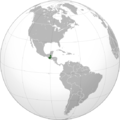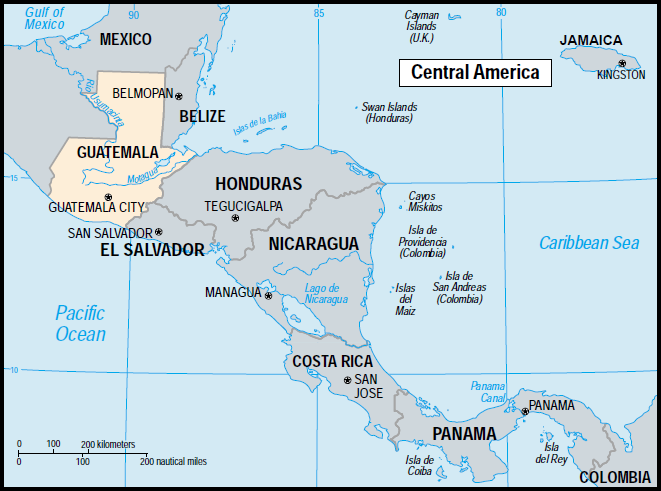Click here to register!
Difference between revisions of "Guatemala Energy Situation"
***** (***** | *****) m |
***** (***** | *****) |
||
| Line 78: | Line 78: | ||
<br/> | <br/> | ||
| + | |||
| + | The country enjoys a wealth of renewable resources, though they are not yet utilized to their full potential<ref name="British Embassy Guatemala City. (2013). Guatemala: Energy Sector Opportunities for UK Companies. Retrieved From: https://assets.publishing.service.gov.uk/government/uploads/system/uploads/attachment_data/file/200567/GUATEMALA_-_Energy_Sector_Report_2013.pdf">British Embassy Guatemala City. (2013). Guatemala: Energy Sector Opportunities for UK Companies. Retrieved From: https://assets.publishing.service.gov.uk/government/uploads/system/uploads/attachment_data/file/200567/GUATEMALA_-_Energy_Sector_Report_2013.pdf</ref>. For example; out of possible 5000MW hydroelectric power potential, Guatemala uses only 853 MW (17.06%), and of 1000MW potential of geothermal energy, the country uses just 49.2MW (4.92%)<ref name="British Embassy Guatemala City. (2013). Guatemala: Energy Sector Opportunities for UK Companies. Retrieved From: https://assets.publishing.service.gov.uk/government/uploads/system/uploads/attachment_data/file/200567/GUATEMALA_-_Energy_Sector_Report_2013.pdf">British Embassy Guatemala City. (2013). Guatemala: Energy Sector Opportunities for UK Companies. Retrieved From: https://assets.publishing.service.gov.uk/government/uploads/system/uploads/attachment_data/file/200567/GUATEMALA_-_Energy_Sector_Report_2013.pdf</ref>. <br/> | ||
| + | |||
| + | | ||
== Energy Access == | == Energy Access == | ||
Revision as of 08:07, 18 October 2018
Capital:
Guatemala City
Region:
Coordinates:
14.38°N, 90.30°W
Total Area (km²): It includes a country's total area, including areas under inland bodies of water and some coastal waterways.
108,890
Population: It is based on the de facto definition of population, which counts all residents regardless of legal status or citizenship--except for refugees not permanently settled in the country of asylum, who are generally considered part of the population of their country of origin.
17,357,886 (2022)
Rural Population (% of total population): It refers to people living in rural areas as defined by national statistical offices. It is calculated as the difference between total population and urban population.
47 (2022)
GDP (current US$): It is the sum of gross value added by all resident producers in the economy plus any product taxes and minus any subsidies not included in the value of the products. It is calculated without making deductions for depreciation of fabricated assets or for depletion and degradation of natural resources.
95,003,330,316 (2022)
GDP Per Capita (current US$): It is gross domestic product divided by midyear population
5,473.21 (2022)
Access to Electricity (% of population): It is the percentage of population with access to electricity.
97.87 (2021)
Energy Imports Net (% of energy use): It is estimated as energy use less production, both measured in oil equivalents. A negative value indicates that the country is a net exporter. Energy use refers to use of primary energy before transformation to other end-use fuels, which is equal to indigenous production plus imports and stock changes, minus exports and fuels supplied to ships and aircraft engaged in international transport.
32.84 (2014)
Fossil Fuel Energy Consumption (% of total): It comprises coal, oil, petroleum, and natural gas products.
37.38 (2014)
Introduction
Guatemala is located in Central America[1]. It shares its borders with Mexico in the north, Belize and Honduras in the east, and El Salavador in the south[1][2]. On the west, the country borders the Pacific, with a much shorter northeastern Caribbean coastline[1][2]. The country's major cities are: Guatemala city -the capital-, Quetzaltenango, Escuintla, Livingston and Puerto Barrios[1].
Guatemala is divided topographily into four general regions: central-western highlands, southern volcanic regions of the Sierra Madre, tropical coastal lowlands, and the low northern plateau, which is mainly jungle[1][2].
Predominantly, Guatemala is an agricultural socitey, where farming is the major economic activiy, with forestry and mining close behind[1]. The best soils suitable for farming are located on the Pacific coastal line, while the soil in the Peten tends to erode quickly, and highland soils are better protected because of coffee cultivation[1].
Guatemalan climate varies with accordance to the altitude of the region, and the proximity to the coasts[1][2]. The tierra caliente (hot country), which extends from the sea level into 750m above sea level, and its temperature is around 29°-32°C[1]. The tierra templada (temperate country) extends from 750-1660m above sea level, with day temperature 24°-26°C, and night temperatures 15.5°-21°C[1].The tierra fria (cold country) extends above 1660m above sea level with an average temperature of 26°C at day, and 10°C at night[1].
The country's main natural resources are predominantly: petroleum, nickel, rare woods, fish, chicle and hydropower, with approximately 41.2% of the land used for agriculture (14.2% arable land - 8.8% permanent crops - 18.2% permanent pasture), while forest represents 33.6% of the land[3].
In terms of energy, Guatemala comes as the second largest Central American power market, with a total generating capacity of 4.2GW[4]. Guatemala total energy generation capacity in 2016 was 10.9TWh, of which 41% came from fossil-based generation, 24% from large hydro, and 35% was from renewables (small hydro, wind, solar, biomass and geothermal)[4].
Energy Situation
Overview
Guatemala shows high dependency on firewood, especially for residential demand[5][6]. Though the country has a high potential of natural resources for energy generation and production, with approximately 34% of forestry richness of the total national territory, yet Guatemala still highly depends on hydrocarbons for supplying industrial and productivity sectors[3][5].
Due to this high dependency on hydrocarbons, Guatemala categorizes as a net energy importer[5]. However, the Guatemalan authorities have planned and implemented significant measures to change the country's energy mix, and promote further energy production sources, including renewables[5].
Though firewood represents the main source of energy for household/residential across the country (app. 63%), yet, biomass has started to gain significant importance to meet the continuously increasing energy demand[5]. Thus being encouraged by the domestic investment by local sugar industry, which has started producing biodiesel and energy from sugar-cane pulp[5].
| Source | Diesel | Gasoline | Fuel Oil | Biodiesel from Sugar Cane Pulp + Propane |
|---|---|---|---|---|
| Percentage | 12% | 8% | 4% | 3% |
Forced by the continued power supply constraints to meet the increasing demand, the Guatemalan government had to issue more power supply contracts with private companies, which allowed the growth of the installed thermal generation capacity[5]. Thus being nearly 400% during the period 1993-2002, with other facilities being built as well to add more generation capacity to the country's scheme during the same period[5]. Two geothermal-powered plants in particular were installed: Calderas (5MW) in 1998, and Zunil (24MW) in 1999[5].
Guatemala has many natural reserves of both oil and gas[5], yet both are under-utilized. There exist approximately 153 oil wells, however only 58 are currently utilized for oil production[5].
The country enjoys a wealth of renewable resources, though they are not yet utilized to their full potential[5]. For example; out of possible 5000MW hydroelectric power potential, Guatemala uses only 853 MW (17.06%), and of 1000MW potential of geothermal energy, the country uses just 49.2MW (4.92%)[5].
Energy Access
Production
Installed Capcity
Consumption
Import and Export
Electricity
Energy Security
Renewable Energy
Fossil Fuels
Key Problems of the Energy Sector
Policy Framework, Laws and Regulations
Institutional Set up in the Energy Sector
Other Key Actors / Activities of Donors, Implementing Agencies, Civil Society Organisations
Further Information
References
- ↑ 1.00 1.01 1.02 1.03 1.04 1.05 1.06 1.07 1.08 1.09 1.10 https://info.publicintelligence.net/MCIA-GuatemalaHandbook.pdf
- ↑ 2.0 2.1 2.2 2.3 https://eneken.ieej.or.jp/data/4474.pdf
- ↑ 3.0 3.1 https://www.cia.gov/library/publications/the-world-factbook/geos/gt.html
- ↑ 4.0 4.1 http://global-climatescope.org/en/country/guatemala/#/enabling-framework
- ↑ 5.00 5.01 5.02 5.03 5.04 5.05 5.06 5.07 5.08 5.09 5.10 5.11 5.12 5.13 British Embassy Guatemala City. (2013). Guatemala: Energy Sector Opportunities for UK Companies. Retrieved From: https://assets.publishing.service.gov.uk/government/uploads/system/uploads/attachment_data/file/200567/GUATEMALA_-_Energy_Sector_Report_2013.pdf
- ↑ Espinasa, R. Balza, L. Hinestrosa, C. and Sucre, C. (2013). Energy Dossier: Guatemala. Retrieve From: https://publications.iadb.org/bitstream/handle/11319/3856/Dossier%2005%20Guatemala%20Eng.pdf?sequence=6&isAllowed=y























